An Alternative Approach for the Synthesis of Zinc Aluminate Nanoparticles for CO and Propane Sensing Applications
Abstract
:1. Introduction
2. Materials and Methods
2.1. Synthesis of ZnAl2O4
2.2. Physical Characterization
2.3. Sensing Response
3. Results
3.1. Diffraction Analysis
3.2. SEM Analysis
3.3. TEM Analysis
3.4. Nitrogen Adsorption
3.5. UV-Vis Analysis
3.6. Gas Response Measurements
4. Conclusions
Author Contributions
Funding
Institutional Review Board Statement
Informed Consent Statement
Data Availability Statement
Acknowledgments
Conflicts of Interest
References
- Hee-Tae, J. The present and future or gas sensors. ACS Sens. 2022, 7, 912–913. [Google Scholar]
- Sun, Y.-F.; Liu, S.-B.; Meng, F.-L.; Liu, J.-Y.; Jin, Z.; Kong, L.-T.; Liu, J.-H. Metal Oxide Nanostructures and Their Gas Sensing Properties: A Review. Sensors 2012, 12, 2610–2631. [Google Scholar] [CrossRef] [PubMed]
- Korotcenkov, G. Metal oxides for solid-state gas sensors: What determines our choice? Mater. Sci. Eng. B 2007, 139, 1–23. [Google Scholar] [CrossRef]
- Kanan, S.M.; El-Kadri, O.M.; Abu-Yousef, I.A.; Kanan, M.C. Semiconducting Metal Oxide Based Sensors for Selective Gas Pollutant Detection. Sensors 2009, 9, 8158–8196. [Google Scholar] [CrossRef]
- Liu, X.; Cheng, S.; Liu, H.; Hu, S.; Zhang, D.; Ning, H. A Survey on Gas Sensing Technology. Sensors 2012, 12, 9635–9665. [Google Scholar] [CrossRef]
- Ramgir, N.S.; Yang, Y.; Zacharias, M. Nanowire-Based Sensors. Small 2010, 6, 1705–1722. [Google Scholar] [CrossRef]
- Wang, C.; Yin, L.; Zhang, L.; Xiang, D.; Gao, R. Metal Oxide Gas Sensors: Sensitivity and Influencing Factors. Sensors 2010, 10, 2088–2106. [Google Scholar] [CrossRef]
- Huang, J.; Wan, Q. Gas Sensors Based on Semiconducting Metal Oxide One-Dimensional Nanostructures. Sensors 2009, 9, 9903–9924. [Google Scholar] [CrossRef]
- Hoppe, M.; Lupan, O.; Postica, V.; Wolff, N.; Duppel, V.; Kienle, L.; Tiginyanu, I.; Adelung, R. ZnAl2O4-Functionalized Zinc Oxide Microstructures for Highly Selective Hydrogen Gas Sensing Applications. Phys. Status Solidi A 2018, 215, 1700772. [Google Scholar] [CrossRef]
- Morán-Lázaro, J.-P.; Guillén-López, E.S.; López-Urias, F.; Muñoz-Sandoval, E.; Blanco-Alonso, O.; Guillén-Bonilla, H.; Guillén-Bonilla, A.; Rodríguez-Betancourt, V.-M.; Sánchez-Tizapa, M.; Olvera-Amador, M. Synthesis of ZnMn2O4 nanoparticles by a microwave-assisted colloidal method and their evaluation as a gas sensor of propane and carbon monoxide. Sensors 2018, 18, 701. [Google Scholar] [CrossRef]
- Ma, P.; Li, X.; Zhang, Y.; Han, L.; Xu, Y. Hierarchical spinel-type corn-like MGa2O4 (M = Ni, Co) architectures for selective triethylamine gas sensors. Mater. Sci. Semicond. Process. 2021, 133, 105993. [Google Scholar] [CrossRef]
- Kapse, S.-D.; Raghuwanshi, F.-C.; Kapse, V.-D.; Patil, D.-R. Characteristics of high sensitivity ethanol gas sensors based on nanostructured spinel Zn1−xCoxAl2O4. Curr. Appl. Phys. 2012, 12, 307–312. [Google Scholar] [CrossRef]
- Zhang, H.; Hu, J.; Li, M.; Li, Z.; Yuan, Y.; Yang, X.; Guo, L. Highly efficient toluene gas sensor based on spinel structured hollow urchin-like core-shell ZnFe2O4 spheres. Sens. Actuators B Chem. 2021, 349, 130734. [Google Scholar] [CrossRef]
- Zhao, H.; Li, J.; Wang, Y.; Zhang, R.; Zou, C.; Zhou, Y. Black phosphorus nanosheets decorated multiscale zinc ferrite spheres towards swift and humidity-tolerant breath acetone sensing. IEEE Sens. J. 2022; early access. [Google Scholar] [CrossRef]
- Dixit, H.; Tandon, N.; Cottenier, S.; Saniz, R.; Lamoen, D.; Partoens, B. First-principles study of possible shallow donors in ZnAl2O4 spinel. Phys. Rev. B 2013, 87, 174101. [Google Scholar] [CrossRef]
- Singh, V.; Singh, N.; Pathak, M.S.; Dubey, V.; Singh, P.K. Annealing effects on the luminescence properties of Ce doped ZnAl2O4 produced by combustion synthesis. Optik 2018, 155, 285–291. [Google Scholar] [CrossRef]
- Belyaev, A.V.; Evdokimov, I.I.; Drobotenko, V.V.; Sorokin, A.A. A new approach to producing transparent ZnAl2O4 ceramics. J. Eur. Ceram. Soc. 2017, 37, 2747–2751. [Google Scholar] [CrossRef]
- Grabowska, H.; Mista, W.; Trawczynski, J.; Wrzyszcz, J.; Zawadzki, M. Thermal stability of platinum supported zinc aluminate combustion catalysts. J. Chem. 2001, 75, 1561–1568. [Google Scholar]
- Ianos, R.; Borcanescu, S.; Lazau, R. Large surface area ZnAl2O4 powders prepared by a modified combustion technique. Chem. Eng. J. 2014, 240, 260–263. [Google Scholar] [CrossRef]
- Cheng, B.; Ouyang, Z.; Tian, B.; Xiao, Y.; Lei, S. Porous ZnAl2O4 spinel nanorods: High sensitivity humidity sensors. Ceram. Int. 2013, 39, 7379–7386. [Google Scholar] [CrossRef]
- Kapse, V.D. Preparation of Nanocrystalline Spinel-type oxide Materials for Gas sensing applications. Res. J. Chem. Sci. 2015, 5, 7–12. [Google Scholar]
- Guan, M.Y.; Xu, D.M.; Song, Y.F.; Guo, Y. ZnO/ZnAl2O4 Prepared by Calcination of ZnAl Layered Double Hydroxides for Ethanol Sensing. Sens. Actuators B 2013, 188, 1148–1154. [Google Scholar] [CrossRef]
- Belyaev, A.V.; Lelet, M.I.; Kirillova, N.I.; Khamaletdinova, N.M.; Boldin, M.S.; Murashov, A.A.; Balabanov, S.S. Sol-gel synthesis and characterization of ZnAl2O4 powders for transparent ceramics. Ceram. Int. 2019, 45, 4835–4839. [Google Scholar] [CrossRef]
- Mekprasart, W.; Boonyarattanakalin, K.; Pecharapa, W.; Ishihara, K.N. Optical characteristics of samarium doped ZnAl2O4 nanomaterials synthesized by vibrational milling process. Mater. Today-Proc. 2018, 5, 14126–14130. [Google Scholar] [CrossRef]
- Stringhini, F.M.; Foletto, E.L.; Sallet, D.; Bertuol, D.A.; Chiavone-Filho, O.; do Nascimento, C.A.O. Synthesis of porous zinc aluminate spinel (ZnAl2O4) by metal-chitosan complexation method. J. Alloy Comp. 2014, 588, 305–309. [Google Scholar] [CrossRef]
- Gildo-Ortiz, L.; Reyes-Gómez, J.; Flores-Álvarez, J.M.; Guillén-Bonilla, H.; Olvera, M.L.; Rodríguez-Betancourtt, V.M.; Verde-Gómez, Y.; Guillén-Cervantes, A.; Santoyo-Salazar, J. Synthesis, characterization and sensitivity tests of perovskite-type LaFeO3 nanoparticles in CO and propane atmospheres. Ceram. Int. 2016, 42, 18821–18827. [Google Scholar] [CrossRef]
- Guillén-Bonilla, H.; Reyes-Gómez, J.; Guillén-Bonilla, A.; Pozas-Zepeda, D.; Guillén-Bonilla, J.T.; Gildo-Ortiz, L.; Flores-Martínez, M. Synthesis and characterization of MgSb2O6 trirutile-type in low presence concentrations of ethylenediamine. J. Chem. Chem. Eng. 2013, 7, 395–401. [Google Scholar]
- Guillén-Bonilla, A.; Rodríguez-Betancourtt, V.M.; Guillén-Bonilla, J.T.; Sánchez-Martínez, A.; Gildo-Ortiz, L.; Santoyo-Salazar, J.; Morán-Lázaro, J.P.; Guillén-Bonilla, H.; Blanco-Alonso, O. A novel CO and C3H8 sensor made of CuSb2O6 nanoparticles. Ceram. Int. 2017, 43, 13635–13644. [Google Scholar] [CrossRef]
- Mirzaei, A.; Neri, G. Microwave-assisted synthesis of metal oxide nanostructures for gas sensing application: A review. Sens. Actuators B Chem. 2016, 237, 749–775. [Google Scholar] [CrossRef]
- Regmi, G.; Rohini, M.; Reyes Figueroa, P.; Maldonado, A.; Olvera, M.L.; Velumani, S. Deposition and characterization of ultrathin intrinsic zinc oxide (i-ZnO) films by radio frequency (RF) sputtering for propane gas sensing application. J. Mater. Sci.-Mater. 2018, 29, 15682–15692. [Google Scholar] [CrossRef]
- Holzwarth, U.; Gibson, N. The Scherrer equation versus the ‘Debye-Scherrer equation’. Nat. Nanotechnol. 2011, 6, 534. [Google Scholar] [CrossRef] [PubMed]
- Ruiz-Trejo, J.E.; Santoyo-Salazar, R.; Vilchis-Morales, A.; Benítez-Rico, F.; Gómez-García, C.; Flores-Morales, J.; Chávez-Carvayar, G. Tavizón, Microstructure and electrical transport in nano-grain sized Ce0.9Gd0.1O2−δ ceramics. J. Solid. State Chem. 2007, 180, 3093–3100. [Google Scholar] [CrossRef]
- Wang, X.; Li, Y. Solution-based synthetic strategies for 1-D nanostructures. Inorg. Chem. 2006, 45, 7522–7534. [Google Scholar] [CrossRef]
- Gildo-Ortiz, L.; Guillén-Bonilla, H.; Rodríguez-Betancourtt, V.M.; Blanco-Alonso, O.; Guillén-Bonilla, A.; Santoyo-Salazar, J.; Romero-Ibarra, I.C.; Reyes-Gómez, J. Key processing of porous and fibrous LaCoO3 nanostructures for successful CO and propane sensing. Ceram. Int. 2018, 44, 15402–15410. [Google Scholar] [CrossRef]
- Deng, Z.X.; Wang, C.; Sun, X.M.; Li, Y.D. Structure-directing coordination template effect of ethylenediamine in formations of ZnS and ZnSe nanocrystallites via solvothermal route. Inorg. Chem. 2002, 41, 869–873. [Google Scholar] [CrossRef] [PubMed]
- LaMer, V.K.; Dinegar, R.H. heory, Production and Mechanism of Formation of Monodispersed Hydrosols. J. Am. Chem. Soc. 1950, 72, 4847–4854. [Google Scholar] [CrossRef]
- Gharibshahi, L.; Saion, E.; Gharibshahi, E.; Shaari, A.H.; Matori, K.A. Structural and Optical Properties of Ag Nanoparticles Synthesized by Thermal Treatment Method. Materials 2017, 10, 402. [Google Scholar] [CrossRef]
- Bystrov, V.S.; Piccirillo, C.; Tobaldi, D.M.; Castro, P.M.L.; Coutinho, J.; Kopyl, S.; Pullar, R.C. Oxygen vacancies, the optical band gap (Eg) and photocatalysis of hydroxyapatite: Comparing modelling with measured data. Appl. Catal. B Environ. 2016, 196, 100–107. [Google Scholar] [CrossRef]
- Wang, S.-F.; Sun, G.-Z.; Fang, L.-M.; Lei, L.; Xiang, X.; Zu, X.-T. A comparative study of ZnAl2O4 nanoparticles synthesized from different aluminum salts for use as fluorescence materials. Sci. Rep. 2015, 5, 12849. [Google Scholar] [CrossRef] [PubMed]
- Yuan, Z.; Li, R.; Meng, F.; Zhang, J.; Zuo, K.; Han, E. Approaches to Enhancing Gas Sensing Properties: A Review. Sensors 2019, 19, 1495. [Google Scholar] [CrossRef]
- Wu, K.; Li, J.; Zhang, C. Zinc ferrite based gas sensors: A review. Ceram. Int. 2019, 45, 11143–11157. [Google Scholar] [CrossRef]
- Dey, A. Semiconductor metal oxide gas sensors: A review. Mater. Sci. Eng. B 2018, 229, 206–217. [Google Scholar] [CrossRef]
- Eranna, G.; Joshi, B.C.; Runthala, D.P.; Gupta, R.P. Oxide Materials for Development of Integrated Gas Sensors—A Comprehensive Review. Crit. Rev. Solid State 2004, 29, 111–188. [Google Scholar] [CrossRef]
- Jayaraman, V.K.; Maldonado, A.; Olvera, M.L. A simple and cost-effective zinc oxide thin film sensor for propane gas detection. Mater. Lett. 2015, 157, 169–171. [Google Scholar] [CrossRef]
- Guillén-Bonilla, H.; Gildo-Ortiz, L.; Olvera-Amador, M.L.; Santoyo-Salazar, J.; Rodríguez-Betancourtt, V.M.; Guillén-Bonilla, A.; Reyes-Gómez, J. Sensitivity of mesoporous CoSb2O6 nanoparticles to gaseous CO and C3H8 at low temperatures. J. Nanomater. 2015, 2015, 308465. [Google Scholar] [CrossRef]
- Guillén-Bonilla, H.; Rodríguez-Betancourtt, V.M.; Guillén Bonilla, J.T.; Reyes-Gómez, J.; Gildo-Ortiz, L.; Flores-Martínez, M.; Olvera-Amador, M.L.; Santoyo-Salazar, J. CO and C3H8 sensitivity behavior of zinc antimonate prepared by a microwave-assisted solution method. J. Nanomater. 2015, 2015, 979543. [Google Scholar] [CrossRef]
- Gildo-Ortiz, L.; Guillén-Bonilla, H.; Reyes-Gómez, J.; Rodríguez-Betancourtt, V.M.; Olvera-Amador, M.L.; Eguía-Eguía, S.I.; Guillén-Bonilla, A.; Santoyo-Salazar, J. Facile synthesis, microstructure, and gas sensing properties of NdCoO3 nanoparticles. J. Nanomater. 2017, 2017, 8174987. [Google Scholar] [CrossRef]
- Guillén-Bonilla, H.; Rodríguez-Betancourtt, V.M.; Guillen-Bonilla, J.T.; Gildo-Ortiz, L.; Guillen-Bonilla, A.; Casallas-Moreno, Y.L.; Blanco-Alonso, O.; Reyes-Gómez, J. Sensitivity Tests of Pellets Made from Manganese Antimonate Nanoparticles in Carbon Monoxide and Propane Atmospheres. Sensors 2018, 18, 2299. [Google Scholar] [CrossRef]
- Gildo-Ortiz, L.; Rodríguez-Betancourtt, V.M.; Blanco-Alonso, O.; Guillén-Bonilla, A.; Guillén-Bonilla, J.T.; Guillén-Cervantes, A.; Santoyo-Salazar, J.; Guillén-Bonilla, H. A simple route for the preparation of nanostructured GdCoO3 via the solution method, as well as its characterization and its response to certain gases. Results Phys. 2019, 12, 475–483. [Google Scholar] [CrossRef]
- Bochenkov, V.E.; Sergeev, G.B. Preparation and chemiresistive properties of nanostructured materials. Adv. Colloid Interface Sci. 2005, 116, 245–254. [Google Scholar] [CrossRef]

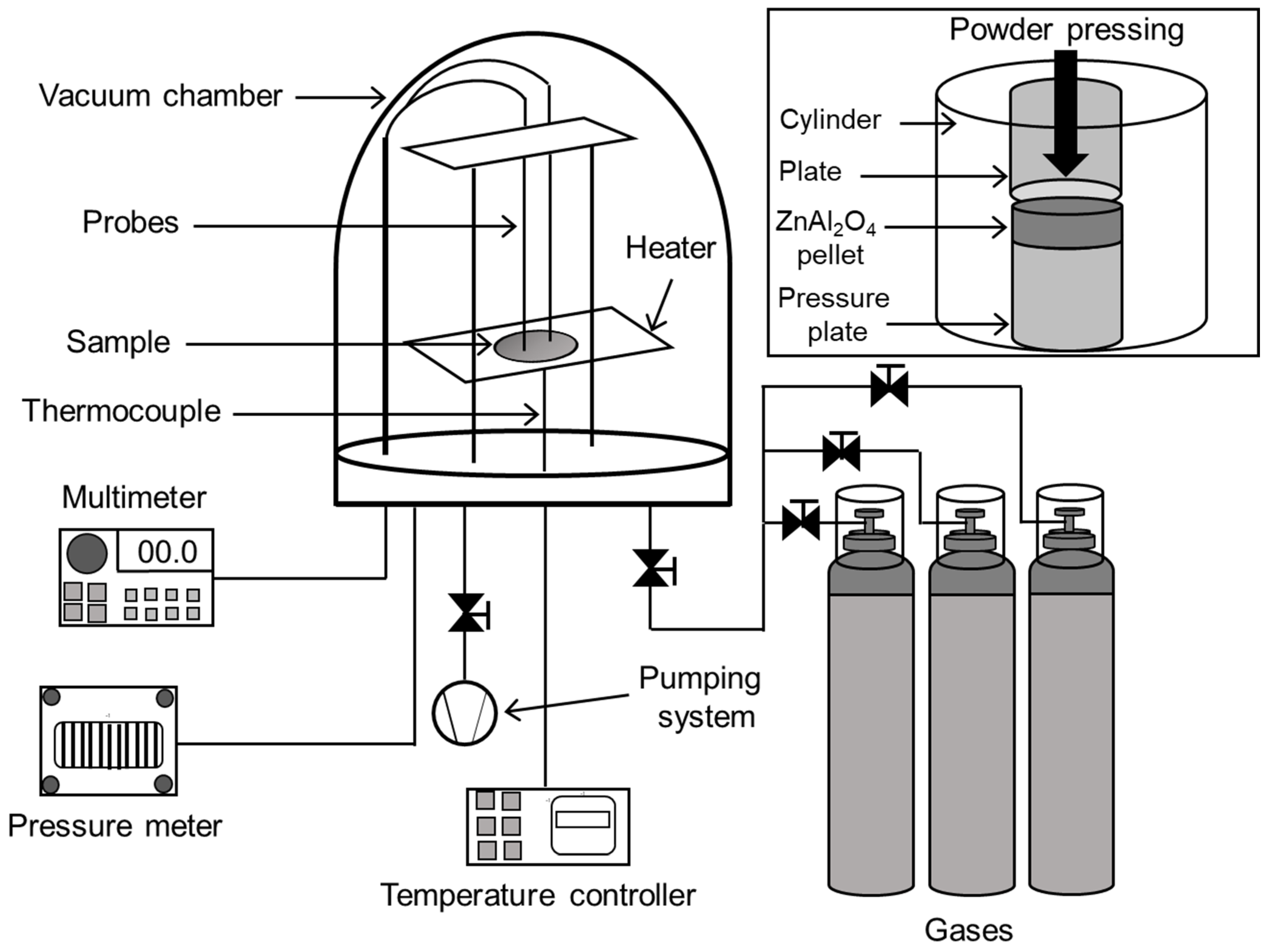
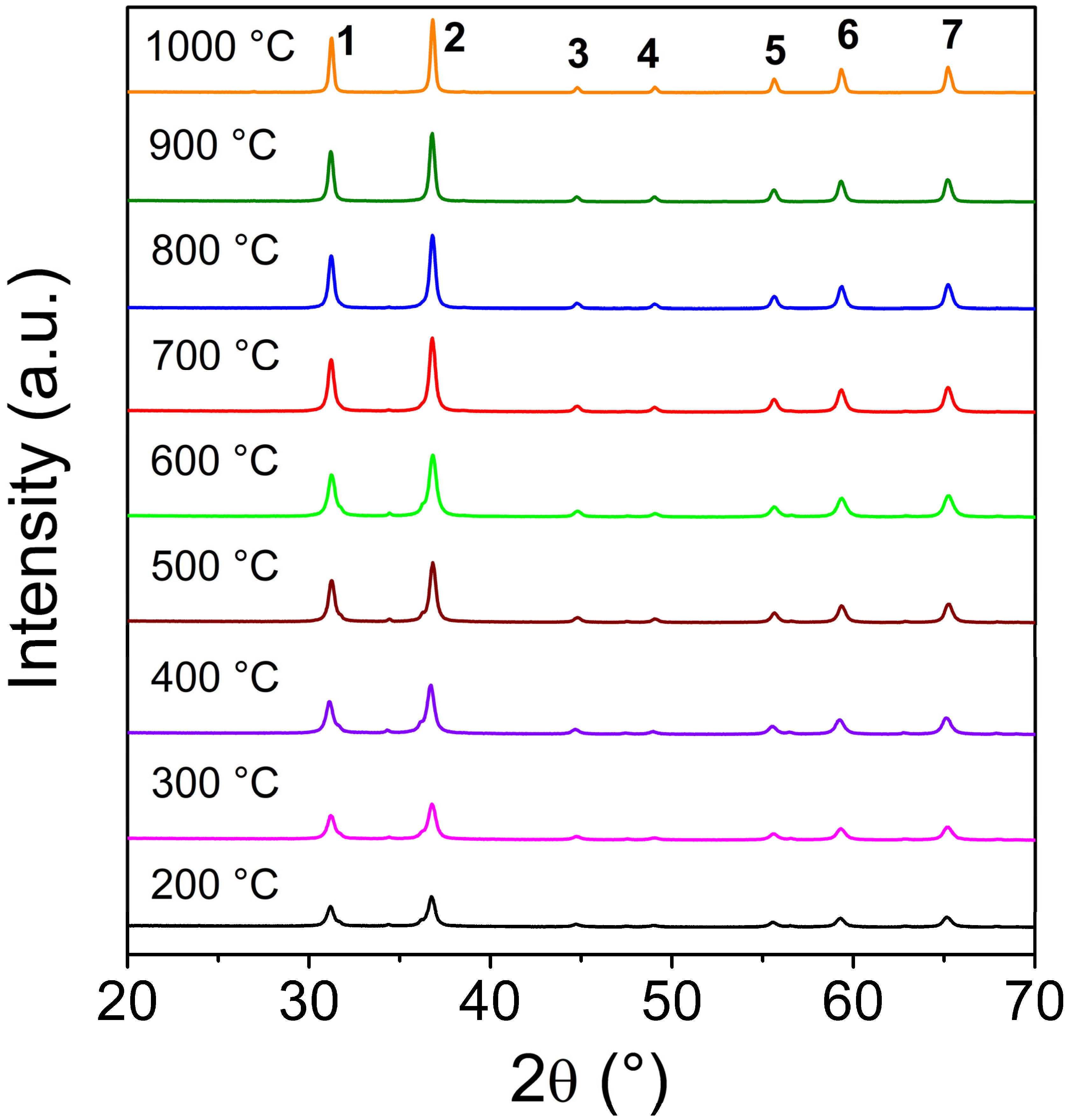
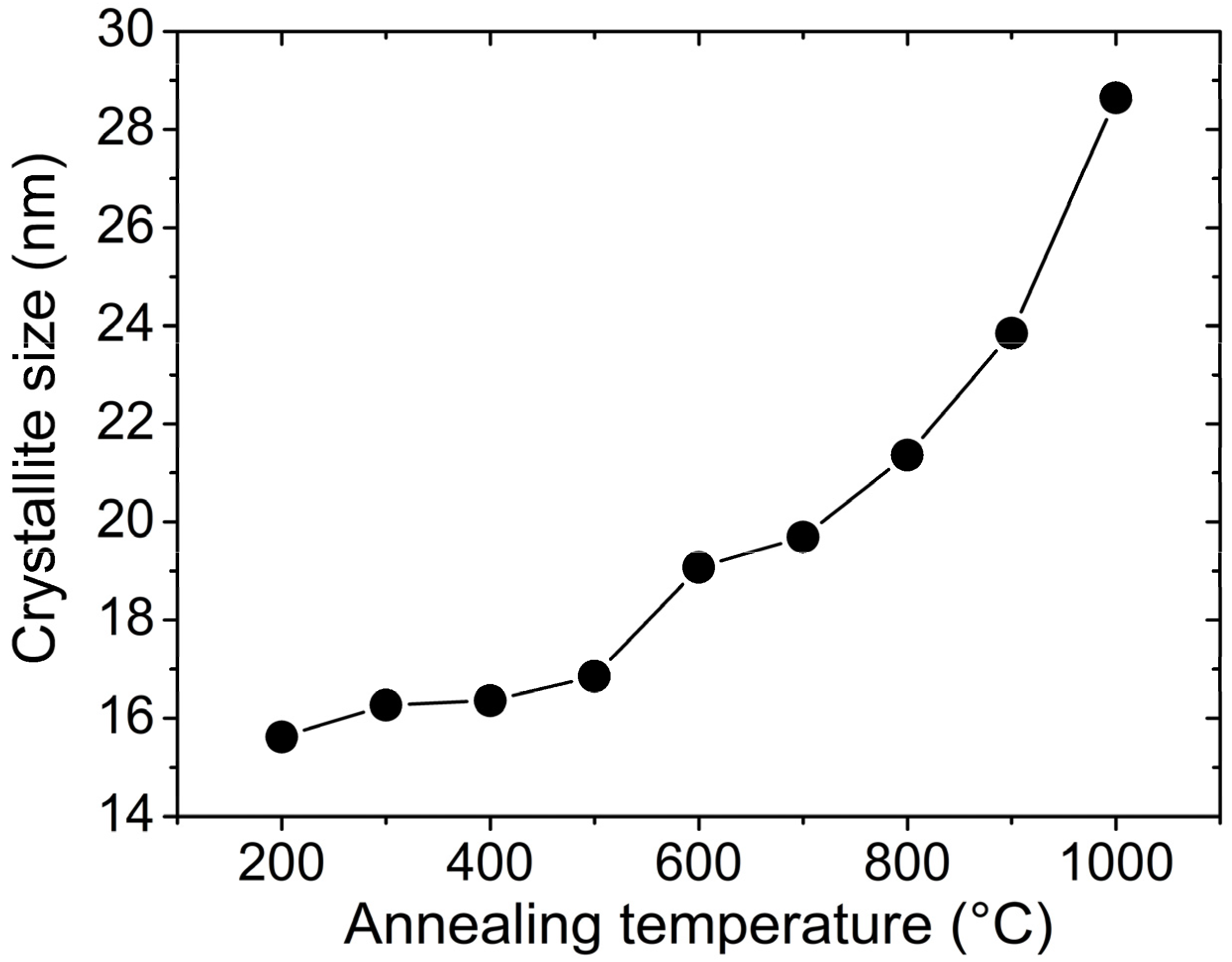

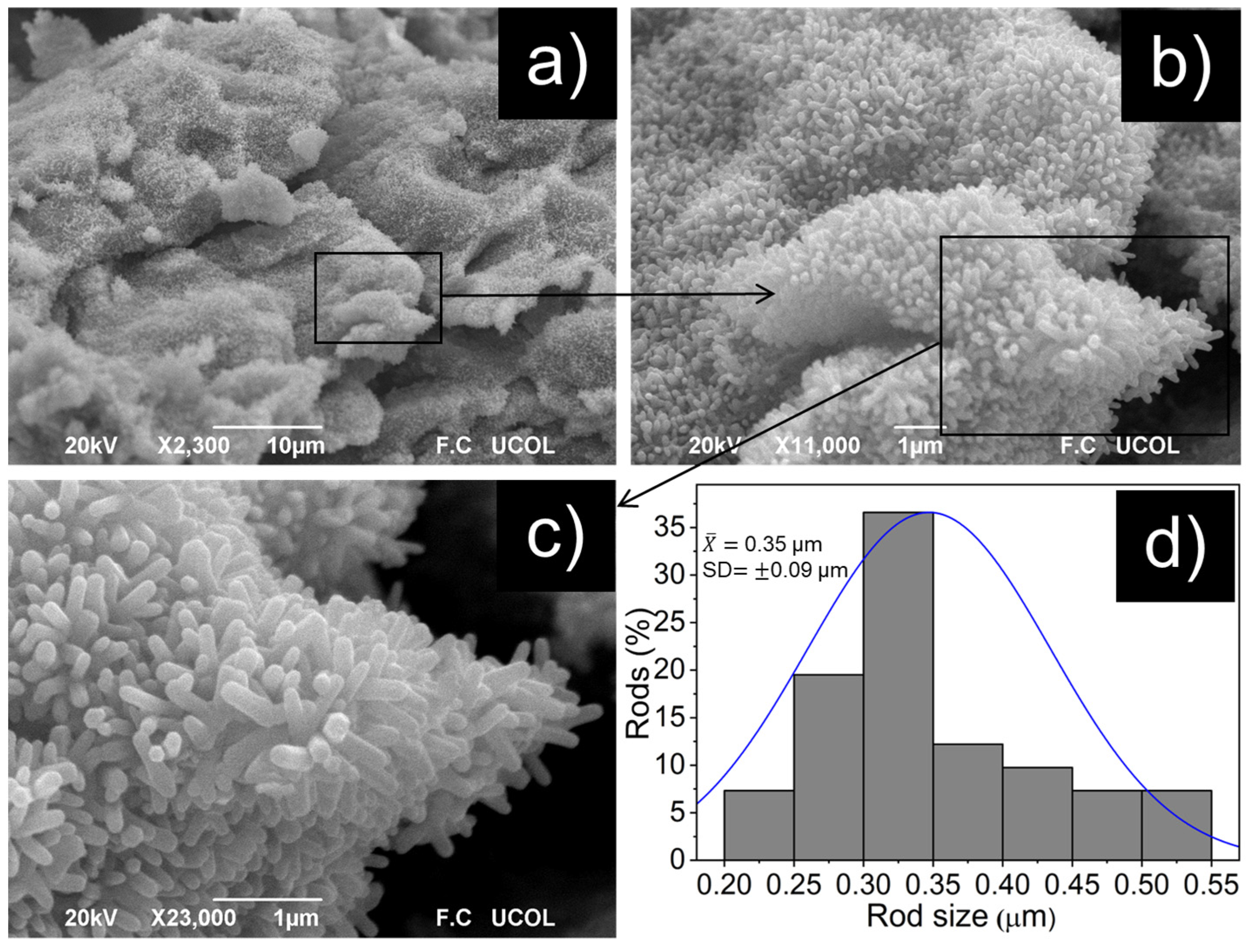
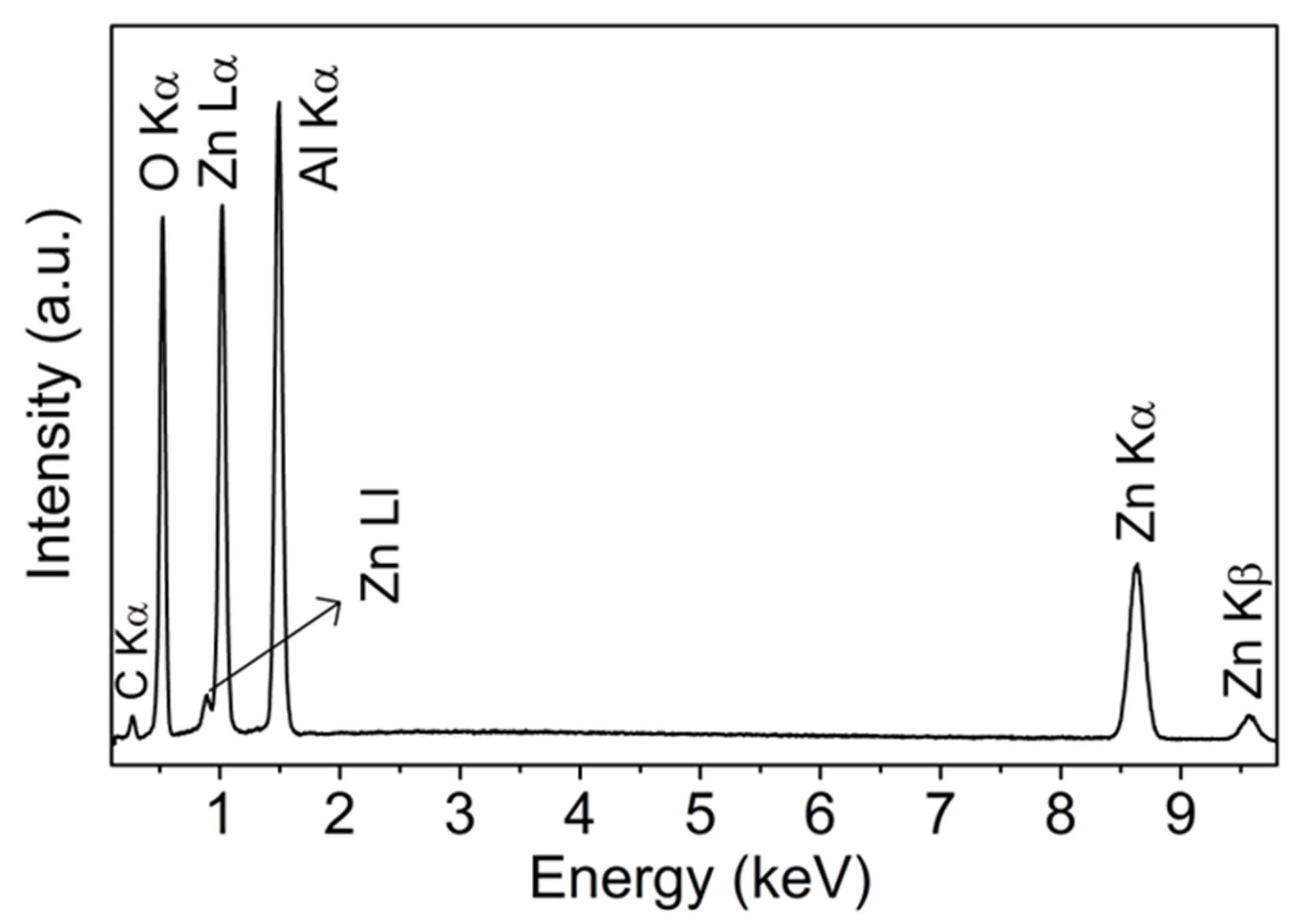
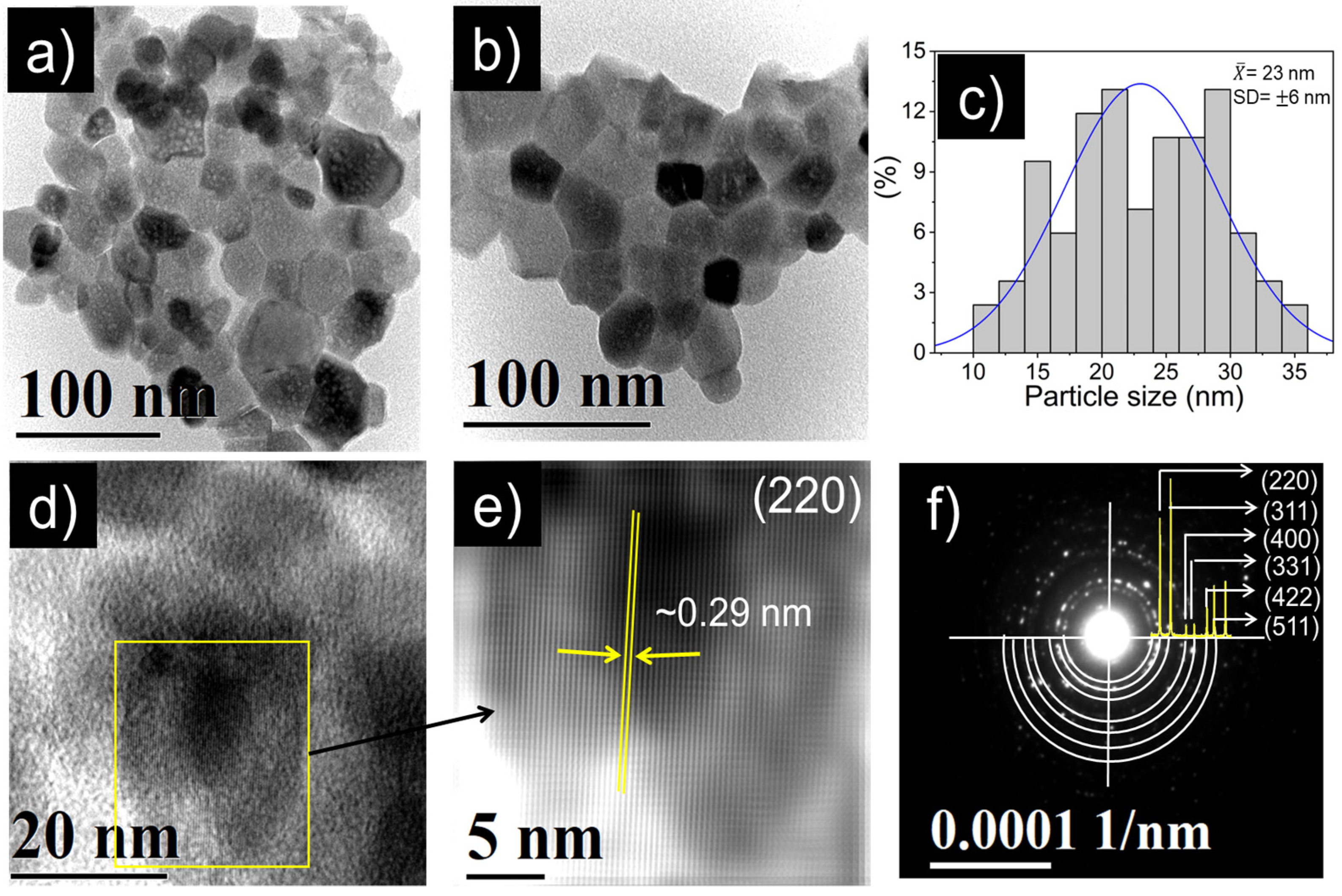
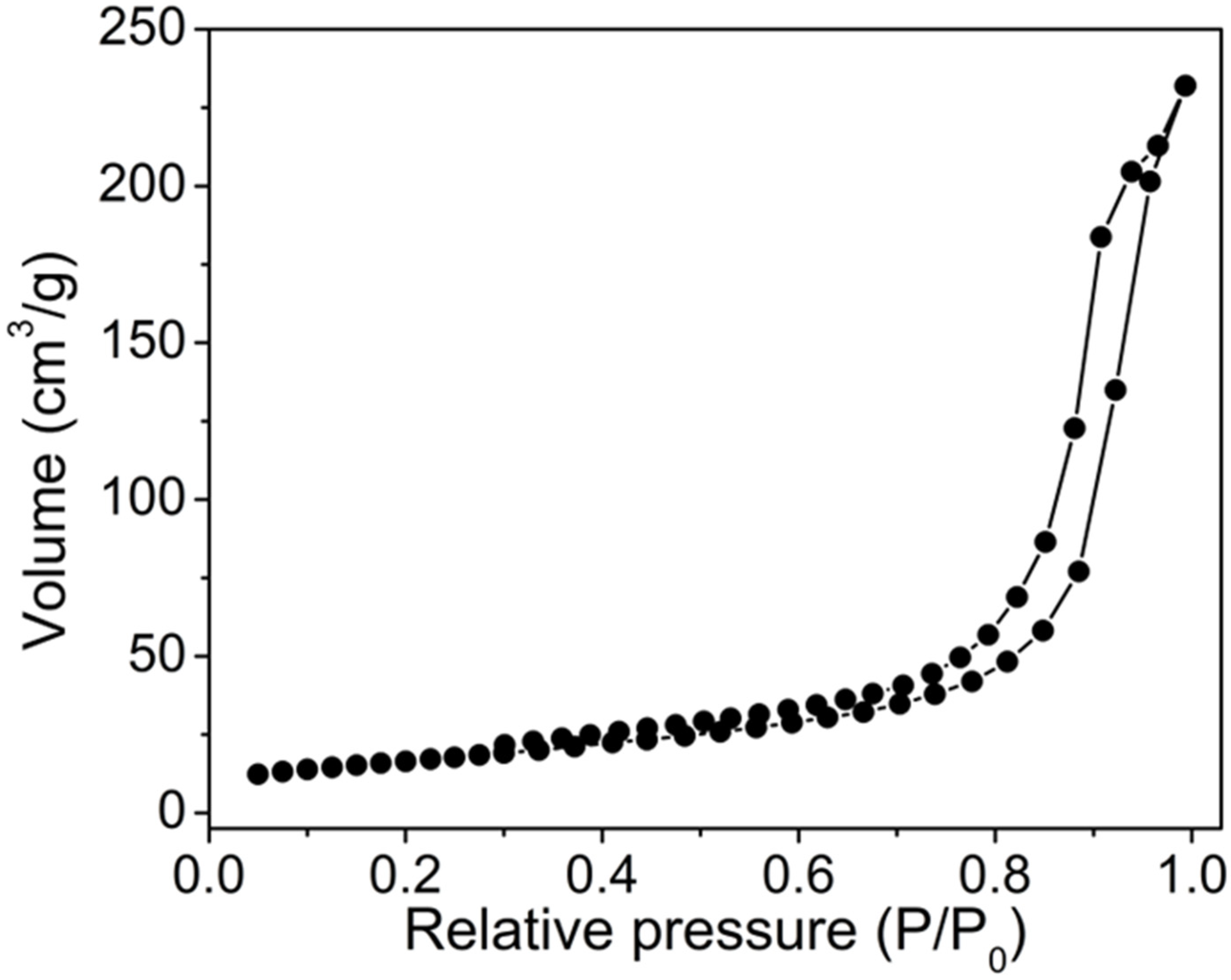



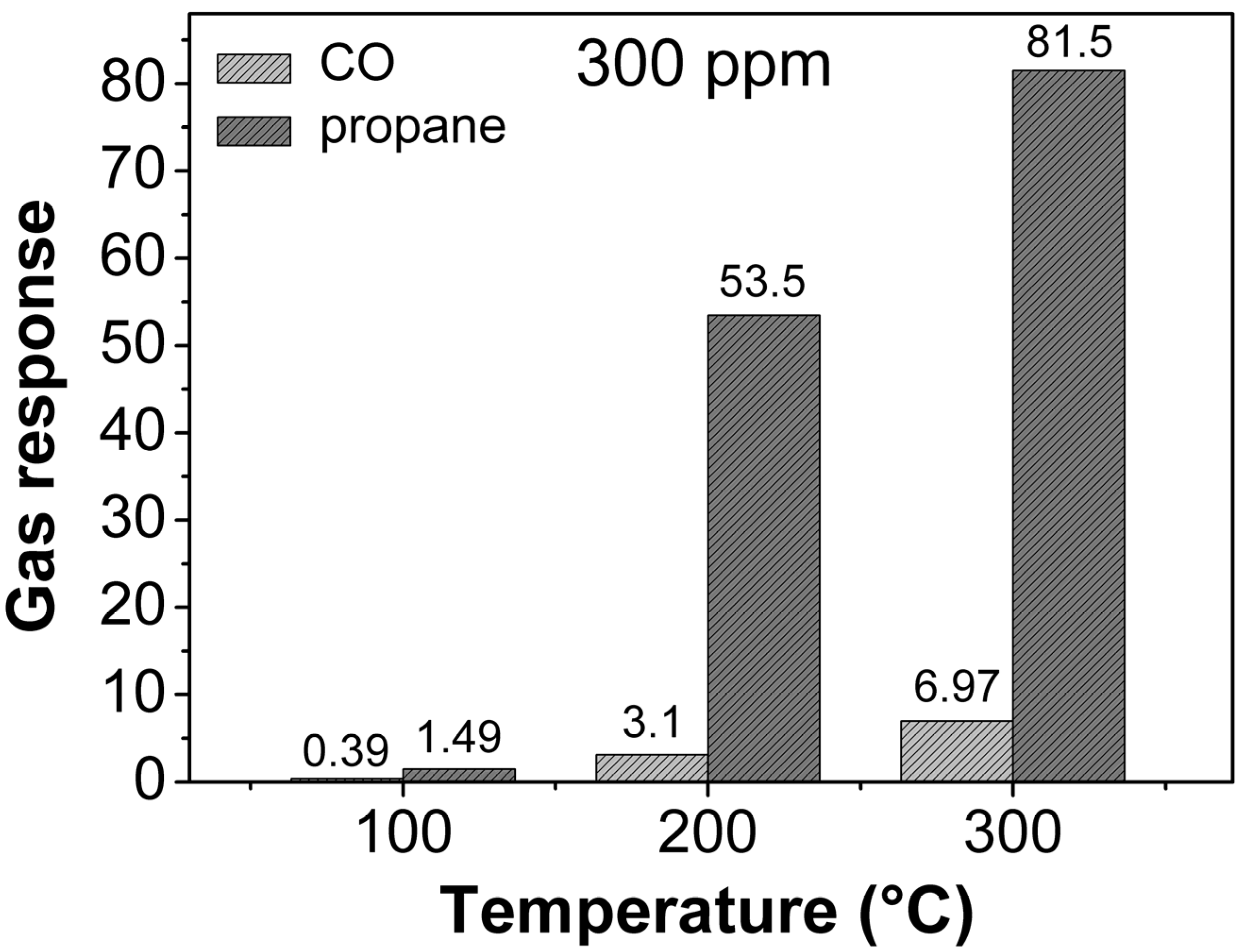


| Peak | 2 (°) | d (Å) | λ2/4a2 | Plane (hkl) | a (Å) |
|---|---|---|---|---|---|
| 1 | 31.4 | 2.9 | 0.00915 | 220 | 8.05 |
| 2 | 36.8 | 2.4 | 0.00915 | 311 | 8.05 |
| 3 | 44.8 | 2.0 | 0.00913 | 400 | 8.06 |
| 4 | 49.2 | 1.9 | 0.00912 | 331 | 8.06 |
| 5 | 55.7 | 1.7 | 0.00912 | 422 | 8.06 |
| 6 | 59.6 | 1.6 | 0.00912 | 511 | 8.06 |
| 7 | 65.3 | 1.4 | 0.00912 | 440 | 8.06 |
| Material | Method | T (°C) | Time (h) | Microstructure | Reference |
|---|---|---|---|---|---|
| Ce:ZnAl2O4 | Solution combustion | 800 | 2 | Microparticles | [16] |
| ZnAl2O4 | Sol–gel and pressing | 750–1600 | 1–3 | Micrograins | [17] |
| ZnAl2O4 | Co-precipitation | 900 | 3 | Nanorods | [20] |
| ZnAl2O4 | Citrated sol-gel | 700 | 5 | Not reported | [21] |
| ZnO/ZnAl2O4 | Calcinations | 600–1000 | 5 | Microblocks | [22] |
| ZnAl2O4 | Sol–gel | 700–900 | 2 | Microparticles | [23] |
| Sm:ZnAl2O4 | Ball milling | 1200 | 6 | Not reported | [24] |
| ZnAl2O4 | Complexation | 500–900 | 4 | Nanocrystals | [25] |
| ZnAl2O4 | Aqueous sol-gel | From 200 | 5 | Nanocrystals | This work |
| Material | Particle Size | Carbon Monoxide | Propane | Reference | ||||
|---|---|---|---|---|---|---|---|---|
| S | C (ppm) | T (°C) | S | C (ppm) | T (°C) | |||
| LaFeO3 | 9–54 nm | 17 | 200 | 350 | 31.4 | 300 | 350 | [26] |
| LaCoO3 | 18–150 nm | 5.5 | 200 | 350 | 29.2 | 300 | 350 | [34] |
| CoSb2O6 | 70–150 nm | 7 | 200 | 350 | 4.8 | 300 | 350 | [45] |
| ZnSb2O6 | Microrods | 6.7 | 300 | 250 | 1.3 | 300 | 250 | [46] |
| NdCoO3 | 17–151 nm | 7.2 | 300 | 300 | 94.1 | 300 | 300 | [47] |
| MnSb2O6 | 10–60 nm | 9 | 300 | 300 | 0.5 | 500 | 300 | [48] |
| GdCoO3 | 85–130 nm | 3 | 300 | 300 | 14.6 | 300 | 300 | [49] |
| ZnAl2O4 | 11–35 nm | 7 | 300 | 300 | 82 | 300 | 300 | This work |
Disclaimer/Publisher’s Note: The statements, opinions and data contained in all publications are solely those of the individual author(s) and contributor(s) and not of MDPI and/or the editor(s). MDPI and/or the editor(s) disclaim responsibility for any injury to people or property resulting from any ideas, methods, instructions or products referred to in the content. |
© 2023 by the authors. Licensee MDPI, Basel, Switzerland. This article is an open access article distributed under the terms and conditions of the Creative Commons Attribution (CC BY) license (https://creativecommons.org/licenses/by/4.0/).
Share and Cite
Gildo-Ortiz, L.; Rodríguez-Betancourtt, V.-M.; Ramírez Ortega, J.A.; Blanco-Alonso, O. An Alternative Approach for the Synthesis of Zinc Aluminate Nanoparticles for CO and Propane Sensing Applications. Chemosensors 2023, 11, 105. https://doi.org/10.3390/chemosensors11020105
Gildo-Ortiz L, Rodríguez-Betancourtt V-M, Ramírez Ortega JA, Blanco-Alonso O. An Alternative Approach for the Synthesis of Zinc Aluminate Nanoparticles for CO and Propane Sensing Applications. Chemosensors. 2023; 11(2):105. https://doi.org/10.3390/chemosensors11020105
Chicago/Turabian StyleGildo-Ortiz, Lorenzo, Verónica-María Rodríguez-Betancourtt, Jorge Alberto Ramírez Ortega, and Oscar Blanco-Alonso. 2023. "An Alternative Approach for the Synthesis of Zinc Aluminate Nanoparticles for CO and Propane Sensing Applications" Chemosensors 11, no. 2: 105. https://doi.org/10.3390/chemosensors11020105
APA StyleGildo-Ortiz, L., Rodríguez-Betancourtt, V. -M., Ramírez Ortega, J. A., & Blanco-Alonso, O. (2023). An Alternative Approach for the Synthesis of Zinc Aluminate Nanoparticles for CO and Propane Sensing Applications. Chemosensors, 11(2), 105. https://doi.org/10.3390/chemosensors11020105





